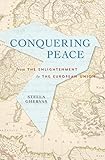Conquering Peace : From the Enlightenment to the European Union / Stella Ghervas.
Material type: TextPublisher: Cambridge, MA : Harvard University Press, [2021]Copyright date: ©2021Description: 1 online resource (432 p.)Content type:
TextPublisher: Cambridge, MA : Harvard University Press, [2021]Copyright date: ©2021Description: 1 online resource (432 p.)Content type: - 9780674975262
- 9780674259072
- Peace-building, European -- History
- Political science -- Europe -- Philosophy
- HISTORY / Europe / General
- Congress System
- Europe
- League of Nations
- Realpolitik
- balance of power
- diplomacy
- engineering of peace
- ideals
- ideas
- international orders and disorders
- longue durée
- peace
- plans of perpetual peace
- spirits
- treaty
- war
- online - DeGruyter
| Item type | Current library | Call number | URL | Status | Notes | Barcode | |
|---|---|---|---|---|---|---|---|
 eBook
eBook
|
Biblioteca "Angelicum" Pont. Univ. S.Tommaso d'Aquino Nuvola online | online - DeGruyter (Browse shelf(Opens below)) | Online access | Not for loan (Accesso limitato) | Accesso per gli utenti autorizzati / Access for authorized users | (dgr)9780674259072 |
Browsing Biblioteca "Angelicum" Pont. Univ. S.Tommaso d'Aquino shelves, Shelving location: Nuvola online Close shelf browser (Hides shelf browser)

|

|

|

|

|

|

|
||
| online - DeGruyter Song of Ourselves : Walt Whitman and the Fight for Democracy / | online - DeGruyter The Banks Did It : An Anatomy of the Financial Crisis / | online - DeGruyter The Letters of Robert Frost : 1929–1936 / | online - DeGruyter Conquering Peace : From the Enlightenment to the European Union / | online - DeGruyter Fugitive Pedagogy : Carter G. Woodson and the Art of Black Teaching / | online - DeGruyter Rotary International and the Selling of American Capitalism / | online - DeGruyter The Suicide of Miss Xi : Democracy and Disenchantment in the Chinese Republic / |
Frontmatter -- Contents -- Figure 1 -- Introduction: Europe and Peace -- 1. The Enlightened Spirit of Peace. Beyond the Treaty of Utrecht -- 2. Beyond the Treaty of Utrecht The Spirit of Vienna. A Balance of Diplomacy -- 3. The Spirit of Geneva. Seeking Peace through a League of Nations -- 4. The Postwar European Spirit. Breakthrough to Unification -- 5. The Spirit of Enlarged Europe. The Flight of the Monarch Butterflies -- Conclusion: Quo Vadis, Europe? -- Abbreviations and Note on Proper Names -- Notes -- Acknowledgments -- Index
restricted access online access with authorization star
http://purl.org/coar/access_right/c_16ec
A bold new look at war and diplomacy in Europe that traces the idea of a unified continent in attempts since the eighteenth century to engineer lasting peace. Political peace in Europe has historically been elusive and ephemeral. Stella Ghervas shows that since the eighteenth century, European thinkers and leaders in pursuit of lasting peace fostered the idea of European unification. Bridging intellectual and political history, Ghervas draws on the work of philosophers from Abbé de Saint-Pierre, who wrote an early eighteenth-century plan for perpetual peace, to Rousseau and Kant, as well as statesmen such as Tsar Alexander I, Woodrow Wilson, Winston Churchill, Robert Schuman, and Mikhail Gorbachev. She locates five major conflicts since 1700 that spurred such visionaries to promote systems of peace in Europe: the War of the Spanish Succession, the Napoleonic Wars, World War I, World War II, and the Cold War. Each moment generated a “spirit” of peace among monarchs, diplomats, democratic leaders, and ordinary citizens. The engineers of peace progressively constructed mechanisms and institutions designed to prevent future wars. Arguing for continuities from the ideals of the Enlightenment, through the nineteenth-century Concert of Nations, to the institutions of the European Union and beyond, Conquering Peace illustrates how peace as a value shaped the idea of a unified Europe long before the EU came into being. Today the EU is widely criticized as an obstacle to sovereignty and for its democratic deficit. Seen in the long-range perspective of the history of peacemaking, however, this European society of states emerges as something else entirely: a step in the quest for a less violent world.
Mode of access: Internet via World Wide Web.
In English.
Description based on online resource; title from PDF title page (publisher's Web site, viewed 01. Dez 2022)


